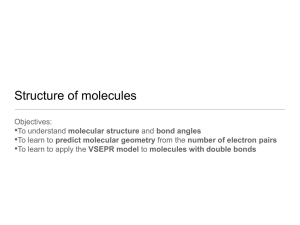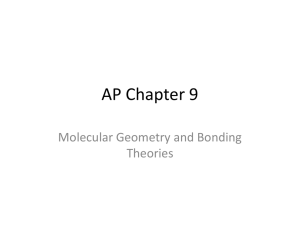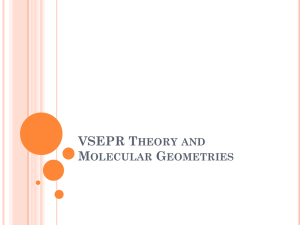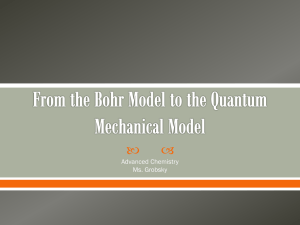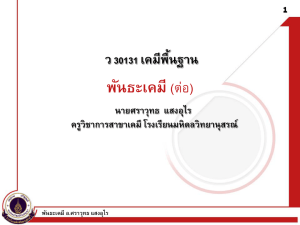Molecular Geometry & Orbital Theory - Chemistry Presentation
advertisement
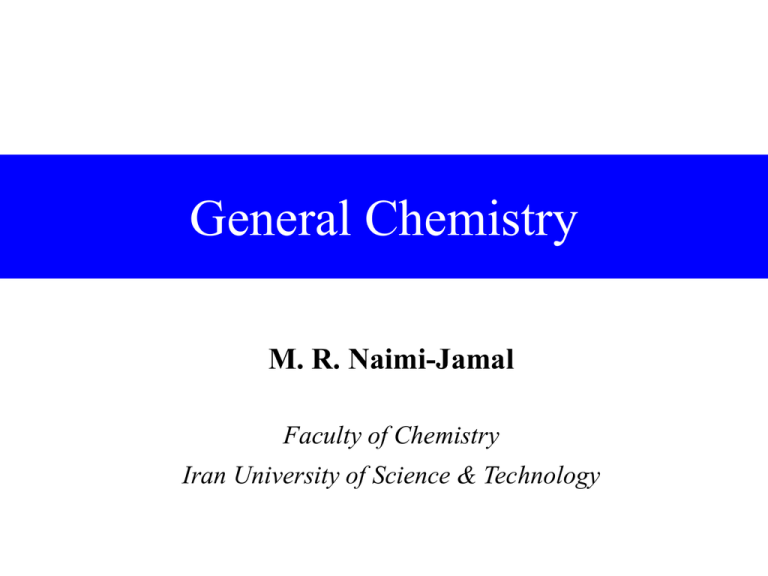
General Chemistry M. R. Naimi-Jamal Faculty of Chemistry Iran University of Science & Technology فصل نهم: شکل هندسی مولکول اوربیتال مولکولی The Shapes of Molecules H O H Terminology VSEPR Theory Valence Shell Electron Pair Repulsion theory Electron pairs repel each other whether they are in chemical bonds (bond pairs) or unshared (lone pairs). Electron pairs assume orientations about an atom to minimize repulsions. Molecular Geometry • Electron group geometry – distribution of e- pairs. • Molecular geometry – distribution of nuclei. • Most important factor in determining geometry is relative repulsion between electron pairs. Balloon Analogy No. of e- Pairs Around Central Atom 2 Example F—Be—F Geometry linear 180 F 3 F planar trigonal B F 120 H 4 C H 109 tetrahedral H H Structure Determination by VSEPR •• H Ammonia, NH3 N H H 1. Draw electron dot structure 2. Count BP’s and LP’s of the central atom: 4 pairs 3. The 4 electron pairs are at the corners of a tetrahedron. lone pair of electrons in tetrahedral position N H H H Structure Determination by VSEPR Ammonia, NH3 The electron pair geometry is tetrahedral. lone pair of electrons in tetrahedral position N H H H The MOLECULAR GEOMETRY — the positions of the atoms — is PYRAMIDAL. Structure Determination by VSEPR Water, H2O •• 1. Draw electron dot structure H O •• 2. Count BP’s and LP’s = 4 3. The 4 electron pairs are at the corners of a tetrahedron. O H H The electron pair geometry is TETRAHEDRAL. H Structure Determination by VSEPR Water, H2O •• H O H •• O H H The molecular geometry is bent. The electron pair geometry is TETRAHEDRAL. Structure Determination by VSEPR Formaldehyde, CH2O • • O • • 1. Draw electron dot structure H C H 2. Count BP’s and LP’s = 3 3. There are 3 electron pairs are at the corners of a planar triangle. • • O • • The electron pair geometry is PLANAR TRIGONAL with 120o bond angles. C H H Structure Determination by VSEPR Formaldehyde, CH2O • • O • • The electron pair geometry is PLANAR TRIGONAL C H H The molecular geometry is also planar trigonal. Structure Determination by VSEPR Methanol, CH3OH 1. Draw electron dot structure H •• H—C—O—H •• 1 H 2 2. Define bond angles 1 and 2 Structure Determination by VSEPR Methanol, CH3OH Define bond angles 1 and 2 Angle 1 = 109o Angle 2 = 109o H •• H—C—O—H •• 109 H 109 In both cases the atom is surrounded by 4 electron pairs. Structure Determination by VSEPR Acetonitrile, CH3CN Draw the electron dot structure Structure Determination by VSEPR Acetonitrile, CH3CN Define bond angles 1 and 2 H 109o 109 H 180 N •• H—C—C Angle 1 = Angle 2 = 180o One C is surrounded by 4 electron “lumps” and the other by 2 “lumps” Phenylalanine, an amino acid 1 H C H H C C C C H C H H 2 H O 3 C C C O H N H H 5 4 H Phenylalanine STRUCTURES WITH CENTRAL ATOMS THAT DO NOT OBEY THE OCTET RULE Compounds with 5 or More Pairs Around the Central Atom 90 F F P Trigonal bipyramid F 120 5 electron pairs F F 90 6 electron pairs F F S F F Octahedron F F 90 Sulfur Tetrafluoride, SF4 Number of valence electrons = 34 •• Central atom = S •• •• F •• Dot structure •• •• •• F •• S •• F •• •• Electron pair geometry = ? F •• •• Sulfur Tetrafluoride, SF4 Number of valence electrons = 34 Central atom = S Dot structure Electron pair geometry = trigonal bipyramid (because 90 there are 5 pairs around the S) •• •• •• F •• •• •• F •• •• S •• F •• •• •• F •• •• F S F F F 120 Sulfur Tetrafluoride, SF4 Lone pair is in the equator because it requires more room. 90 F •• S F F F 120 •• •• F •• •• •• F •• •• S •• F •• •• •• F •• •• Hybridization of Atomic Orbitals sp3 Hybridization Bonding in Methane sp3 Hybridization in Nitrogen Bonding in Nitrogen sp2 Hybridization in Boron Orbitals in Boron sp Hybridization in Be Orbitals in Beryllium sp3d and sp3d2 Hybridization Hybrid Orbitals and VSEPR • Write a plausible Lewis structure. • Use VSEPR to predict electron geometry. • Select the appropriate hybridization. Multiple Covalent Bonds • Ethylene (H2C=CH2) has a double bond in its Lewis structure. • VSEPR says trigonal planar at carbon. Ethylene Acetylene • Acetylene, C2H2, has a triple bond. • VSEPR says linear at carbon. Applying VSEPR Theory • Draw a plausible Lewis structure. • Determine the number of e- groups and identify them as bond or lone pairs. • Establish the e- group geometry. • Determine the molecular geometry. • Multiple bonds count as one group of electrons. • More than one central atom can be handled individually. Molecular Orbital Theory • Atomic orbitals are isolated on atoms. • Molecular orbitals span two or more atoms. • LCAO: – Linear Combination of Atomic Orbitals. Ψ1 = φ1 + φ2 Ψ2 = φ1 - φ2 Combining Atomic Orbitals Molecular Orbitals of Hydrogen Basic Ideas Concerning MOs • Number of MOs = Number of AOs. • Bonding and antibonding MOs formed from AOs. • e- fill the lowest energy MO first. • Pauli exclusion principle is followed. • Hund’s rule is followed Bond Order • Stable species have more electrons in bonding orbitals than antibonding. Bond Order = # e- in bonding MOs - # e- in antibonding MOs 2 Diatomic Molecules of the First-Period BO = (e-bond - e-antibond )/2 BOH += (1-0)/2 = ½ 2 BOH = (2-0)/2 = 1 2 BOHe + = (2-1)/2 = ½ 2 BOHe = (2-2)/2 = 0 2 Molecular Orbitals of the Second Period • First period use only 1s orbitals. • Second period have 2s and 2p orbitals available. • p orbital overlap: – End-on overlap is best – sigma bond (σ). – Side-on overlap is good – pi bond (π). Molecular Orbitals of the Second Period Combining p orbitals Expected MO Diagram of A2 MO Diagram of A2 , Z ≥ 8 Modified MO Diagram of A2 , Z < 8 MO Diagrams of 2nd Period Diatomics Benzene Benzene Ozone Chapter 9 Questions 7, 16, 22, 25, 33 34, 35, 43
